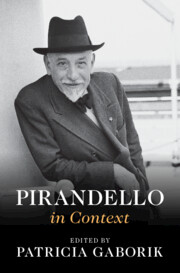Book contents
- Pirandello in Context
- Pirandello in Context
- Copyright page
- Dedication
- Contents
- Figures
- Contributors
- Preface
- Acknowledgments
- Chronology
- List of Cited Titles in Translation and the Original Italian
- Part I Places
- Part II Institutions
- Part III Interlocutors
- Part IV Traditions and Trends, Techniques and Forms
- Part V Culture and Society
- Chapter 25 History
- Chapter 26 Celebrity
- Chapter 27 Cinema
- Chapter 28 Modernity
- Chapter 29 Fascism
- Chapter 30 Women
- Chapter 31 Religion
- Chapter 32 Madness
- Chapter 33 Suicide
- Part VI Reception and Legacy
- Further Reading
- Index
Chapter 31 - Religion
from Part V - Culture and Society
Published online by Cambridge University Press: 14 March 2024
- Pirandello in Context
- Pirandello in Context
- Copyright page
- Dedication
- Contents
- Figures
- Contributors
- Preface
- Acknowledgments
- Chronology
- List of Cited Titles in Translation and the Original Italian
- Part I Places
- Part II Institutions
- Part III Interlocutors
- Part IV Traditions and Trends, Techniques and Forms
- Part V Culture and Society
- Chapter 25 History
- Chapter 26 Celebrity
- Chapter 27 Cinema
- Chapter 28 Modernity
- Chapter 29 Fascism
- Chapter 30 Women
- Chapter 31 Religion
- Chapter 32 Madness
- Chapter 33 Suicide
- Part VI Reception and Legacy
- Further Reading
- Index
Summary
This essay considers religion in Pirandello’s oeuvre from a historical point of view, that is to say, as firmly anchored in a post-Copernican modernity in which, as philosopher Friedrich Nietzsche famously proclaimed, “God is dead,” and relativity came to be understood as scientific fact in the wake of Albert Einstein’s investigations. The essay asks whether a consistent meditation on religion can be found in Pirandello’s oeuvre and therefore considers several works, among them, The Late Mattia Pascal; Shoot!; Lazarus; and One, No One, and One Hundred Thousand. Particular focus is given to the ways in which these writings demonstrate Pirandello’s interest in mysticism, a non-dogmatic Catholic Modernism, and his rejection of any transcendent God, a belief which corresponded to his humoristic view of life more generally, tied as they both were to his uneasiness over life’s lack of certainty.
Keywords
- Type
- Chapter
- Information
- Pirandello in Context , pp. 250 - 256Publisher: Cambridge University PressPrint publication year: 2024

